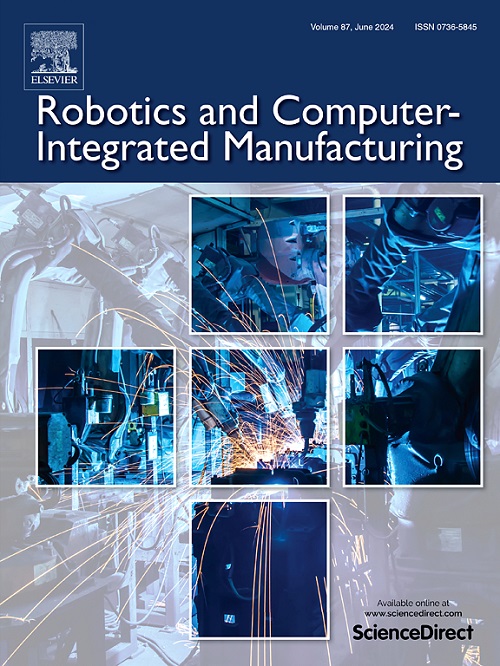通过未知动力学补偿提高物理人机交互的透明度
IF 11.4
1区 计算机科学
Q1 COMPUTER SCIENCE, INTERDISCIPLINARY APPLICATIONS
引用次数: 0
摘要
物理人机交互(pHRi)通常涉及未知负载动态的任务,如运输和组装,这可能会降低透明度、效率和操作员的舒适度。该研究提出了一种补偿器,用于实时调整未知负载动态,通过导纳控制提高透明度。透明度被量化为相互作用力产生的每距离能量,补偿器的设计解决了影响操作员和机器人的未知物理动力学,建模为等效物理系统。利用末端执行器坐标系的相互作用数据和时滞控制方法,对补偿器进行了数学推导,以减轻动态影响,并通过Lyapunov准则验证了其稳定性。模拟和经验测试表明,在不同的运动速度和负载动态情况下,现有控制器的透明度有所提高。本研究强调了动态补偿在提高pHRi透明度方面的作用,并提出了进一步完善低水平动态调整的工作。本文章由计算机程序翻译,如有差异,请以英文原文为准。

Improving transparency in physical human–robot interaction via unknown dynamics compensation
Physical human–robot interaction (pHRi) often involves tasks with unknown load dynamics, such as transport and assembly, which can reduce transparency, efficiency, and operator comfort. This study presents a compensator for real-time adjustment of unknown load dynamics, enhancing transparency through admittance control. Transparency was quantified as energy per distance generated by interaction forces, with the compensator’s design addressing unaccounted physical dynamics affecting both operator and robot, modeled as an equivalent physical system. Utilizing interaction data from the end-effector coordinate system and a time delay control approach, the compensator was mathematically formulated to mitigate dynamic impacts, with stability verified via the Lyapunov criterion. Simulations and empirical tests demonstrated improved transparency over existing controllers across varying motion speeds and load dynamics. This study highlights the role of dynamic compensation in advancing pHRi transparency and proposes future work to refine low-level dynamic adjustments.
求助全文
通过发布文献求助,成功后即可免费获取论文全文。
去求助
来源期刊
CiteScore
24.10
自引率
13.50%
发文量
160
审稿时长
50 days
期刊介绍:
The journal, Robotics and Computer-Integrated Manufacturing, focuses on sharing research applications that contribute to the development of new or enhanced robotics, manufacturing technologies, and innovative manufacturing strategies that are relevant to industry. Papers that combine theory and experimental validation are preferred, while review papers on current robotics and manufacturing issues are also considered. However, papers on traditional machining processes, modeling and simulation, supply chain management, and resource optimization are generally not within the scope of the journal, as there are more appropriate journals for these topics. Similarly, papers that are overly theoretical or mathematical will be directed to other suitable journals. The journal welcomes original papers in areas such as industrial robotics, human-robot collaboration in manufacturing, cloud-based manufacturing, cyber-physical production systems, big data analytics in manufacturing, smart mechatronics, machine learning, adaptive and sustainable manufacturing, and other fields involving unique manufacturing technologies.

 求助内容:
求助内容: 应助结果提醒方式:
应助结果提醒方式:


